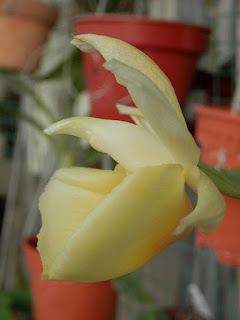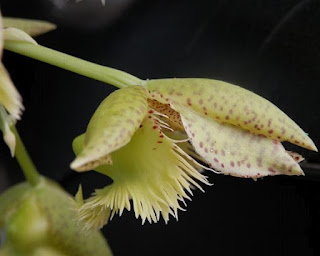sorry to those who read the earlier post about this that is labelled as catasetum sanguineum. i bought this plant labelled as catasetum sanguineum,
catasetum naso and sanguineum looks similar in the sense that both the lip are trilobe, non resupinated, erected peduncle and have a nose like projection at the tip of the lip. however, the borders of the lateral lobes of sanguineum is fully lacerate while catasetum naso's borders are only lacerate near the base. the second most distinguishing character is the pedicles, sanguineum measures only about 10mm while catasetum naso have a longer peidcle of 20mm.
in addition to that, sanguineum flowers are more densely packed at the end of the inflorescence while catasetum naso has flowers that are separated by bracts that are about 30mm apart.
so base on these description, conclusion is made that this plant is Catasetum naso and not sanguineum
second pic on the left shows the lateral lobes of the labellum that is serrated and curves inwards to form an almost complete circle that is interrupted by the trigger pollina. the lateral view shows the prominent nose like projection from the apex of the labellum,
catasetum naso and sanguineum looks similar in the sense that both the lip are trilobe, non resupinated, erected peduncle and have a nose like projection at the tip of the lip. however, the borders of the lateral lobes of sanguineum is fully lacerate while catasetum naso's borders are only lacerate near the base. the second most distinguishing character is the pedicles, sanguineum measures only about 10mm while catasetum naso have a longer peidcle of 20mm.
in addition to that, sanguineum flowers are more densely packed at the end of the inflorescence while catasetum naso has flowers that are separated by bracts that are about 30mm apart.
so base on these description, conclusion is made that this plant is Catasetum naso and not sanguineum
on the left of the first pic is a hermaphrodite flowers, and the right one is the male flower
second pic on the left shows the lateral lobes of the labellum that is serrated and curves inwards to form an almost complete circle that is interrupted by the trigger pollina. the lateral view shows the prominent nose like projection from the apex of the labellum,
the last pic below showing the detail lip appearance of the labellum from inside














